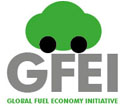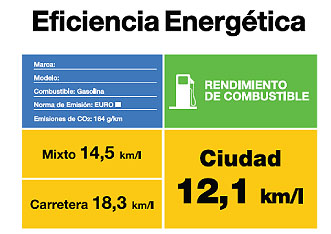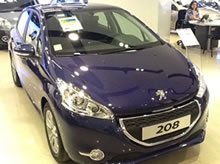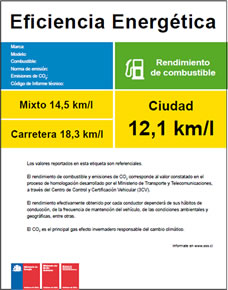
Vehicle labeling for improved fuel economy
The provision of information on vehicle fuel economy is a crucial part of the auto fuel economy policy package. Information on the fuel economy of vehicles is essential if consumers are to understand the choices available to them. In isolation, labeling systems are unlikely to lead to significant fuel efficiency improvements. However, fuel efficiency labels do help consumers compare vehicle choices, and can help consumers understand the tax implications over the lifetime of the vehicle in fiscal regimes that incentivize fuel economy.
Different approaches are taken to vehicle labeling in terms of the metrics, amount and type of information provided, and graphical presentation. Vehicle fuel economy labels usually fall into one of three types, depending on how the information is provided:
- graphical rating (e.g. from A to G) is used in the UK and New Zealand;
- direct information disclosure, by providing the value of the CO2 emissions or fuel economy, is the most common system and used in the US, South Africa, Australia, Singapore, Chile and India; or
- relative vehicle performance compared to the fuel economy standard, used in Japan.
Each approach has advantages and disadvantages. Although the rating-style label may provide a very clear message to vehicle purchasers, the metrics used may be unclear and even controversial, depending on how the ratings are awarded. Simple information disclosure may be more transparent but may be difficult for consumers to relate to. For this reason, many fuel economy labels include not only the fuel economy measured in testing but also the annual fuel costs associated with operating the vehicle. For a detailed explanation of the benefits of each type of labeling approach, the International Energy Agency’s 2012 paper on ‘Improving the Fuel Economy of Road Vehicles: A Policy Package’ is a key source of guidance.
New Vehicles:
- US
- Federal
- California
- UK
- South Africa
- Australia
- Singapore
- New Zealand
- Chile
- India
- Vietnam
- Thailand
United States
A few countries have implemented fuel economy/consumption labeling programs. The longest running program of this type is found in the U.S. Below is the current federal fuel economy label. This label is put on the window of every new car sold in the U.S. Mileage of current U.S. vehicles and back to 1985 can be found on the website http://www.fueleconomy.gov
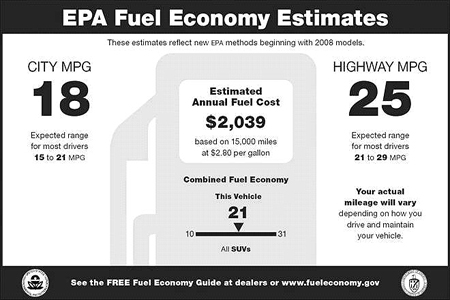
This label shows both the city and highway mileage as well as a combined mileage which is comprised of a 55/45 split of the city and highway tests meant to represent typical driving in the U.S. - see test cycles for a details on the test cycles used.
The California Environmental Performance Label
Since 1978, California’s Smog Index Label has helped consumers assess the relative smog emissions from new cars. The most recent amendments to the program create a more user friendly scoring system for determining the Smog Score and adds a Global Warming Score. Both scores are based on a scale of 1 -10 with 10 being the cleanest and 5 representing an average new car. The Environmental Performance Label also provides the Air Resources Board’s DriveClean.ca.gov website to promote clean vehicle options to new car buyers.
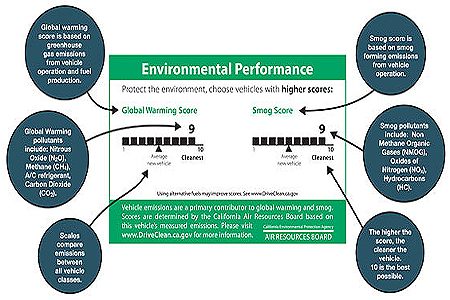
Fuel Economy scores for current vehicles and some past vehicles can be found on http://www.driveclean.ca.gov/.
United Kingdom
From July 2005, a new "Green Label" (shown below) started to appear in car showrooms across the United Kingdom. The "Green Label" is intended to let the consumer know about the environmental impact that a particular car will have by detailing the amount of CO2 the car will produce per kilometer. These bands are consistent with the new road tax prices too, so consumers are able to estimate taxes.
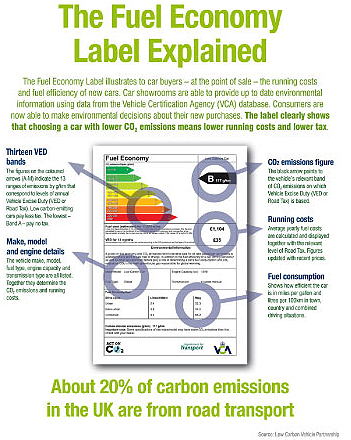
South Africa
In effect from 1st July 2008, the South African Automotive Industry in conjunction with the Department of Minerals and Energy introduced a standard fuel economy and CO2 emission testing and labeling system for new passenger cars at dealerships. The system, which is based on that used in Europe, allows comparison of different models when tested under the same speed, acceleration, and braking cycles while carrying the same load and using the same fuel.
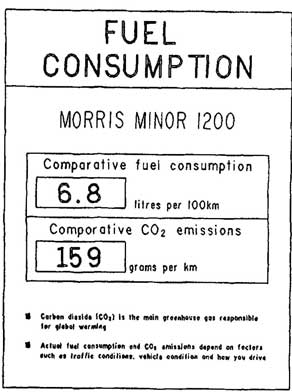
Australia
All new light vehicles sold in Australia are required to display a Fuel Consumption Label on the front windscreen. This includes all passenger cars, four wheel drives and light commercial vehicles up to 3.5 tons gross vehicle mass. The label indicates the vehicle’s fuel consumption in liters of fuel per 100 kilometers (L/100km) and its emissions of carbon dioxide (CO2) in grams per kilometer (g/km).
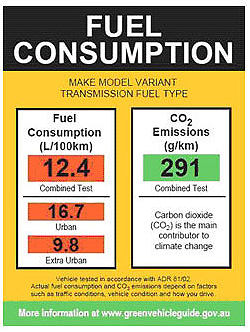
Since April 2009, a new fuel consumption label has been required on showroom vehicles. The new label displays three fuel consumption numbers – ‘combined’, ‘urban’ and ‘extra‐urban’ ‐ as well as the combined CO2 value. The new label highlights the higher fuel consumption of many vehicles operating in urban driving conditions (a factor that tends to be masked in the single ‘combined’ number displayed on the current label).
Singapore Fuel Economy Label
Registered suppliers of motor vehicles must affix a Fuel Economy Label (FEL) on the units that they supply in Singapore. Information on the FEL is based on the Certificate of Registration (COR) issued for the model. Registered suppliers are only allowed to display models that have the label affixed on them.
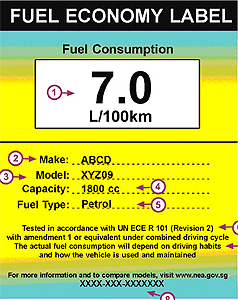
New Zealand
New Zealand does not have a domestic auto manufacturing industry and imports new and used passenger vehicles. In 2007 a regulation was adopted that required from 2008 that all new cars, and all cars manufactured since 2000 and imported after February 2005 into New Zealand, must display information about the vehicle’s fuel economy when the vehicle is offered for sale. The regulation requires motor vehicle dealers to attach a fuel economy label to a vehicle when it is exposed for sale. Internet sales are also included with the fuel economy rating, in the form of text, being required for all internet sales including private sales.
New entrants to New Zealand’s light vehicle fleet are around 50% new and 50% second hand imported vehicles. New vehicle fuel economy information is based on tests on the European Combined Drive Cycle, while imported used vehicles usually have been tested on the Japanese domestic drive cycle. Due to the differences between the two test methods, New Zealand developed an algorithm to align the results of the two methods and to disclose the information in a common star rating format.
For new vehicles, the fuel economy value in litres per 100 km is disclosed on the label. Used vehicles only have the star rating. Another feature of the labeling scheme is the user-friendly way information is populated on websites. A seller only has to enter the vehicle plate number or chassis number or VIN number for the information to be automatically populated onto an advertisement. This demonstrates a practical low cost solution to fuel economy labeling for countries without the vehicle testing and enforcement infrastructure to introduce a new test system. It could also be used as a model for countries introducing minimum fuel economy standards and related fiscal measures without developing a new driving cycle and certification system.
The labeling regulations came into effect in April 2008, and information is expressed as:
- fuel economy cost per year
- fuel economy rating out of 6 stars
- fuel economy litres per 100km
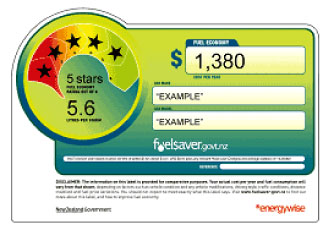
Chile:
Chile is the first Latin American nation to put in place a national label, mandatory from February 2013. Every car in a show room must have a label in the wind shield showing the fuel economy in kilometers per liter tested in the New European Driven Cycle, including also CO2 emissions and local pollutant emission standards that the vehicle model meets. The information came from the type approval process that is done in Chile in the Center for Vehicle Control and Certification (3CV) of the Transport Ministry of Chile. This is a joint initiative developed between Transport, Energy and Environmental Ministries. The labeling program was designed with Global Fuel Economy Initiative support by the Centro Mario Molina Chile.
Read more about Chile’s fuel economy approach here.
India:
India, as of 2010, has a voluntary fuel efficiency labeling system for new vehicles. After 2011, the label will become mandatory for all new vehicles.
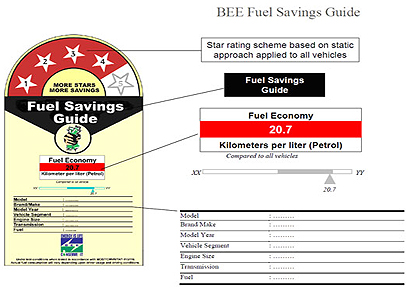
Vietnam
The Vietnamese government launched its fuel economy labeling program on 1 January 2015 for locally assembled and imported cars with up to 7 seats. The car manufacturers or importers are allowed to publish their fuel economy data for car models tested in Vietnam or in foreign reputable laboratories. As of end of February, a total of 205 car models have published fuel economy ratings by car manufacturers or importers and 46 models have been locally verified. The tested value should not exceed the declared value of manufacturer or importer by more than 4%. According to Vietnam Register who is leading this initiative, the emission and fuel consumption test can be integrated in one test.
The label includes: (a) name, address, telephone, fax of manufacturer or importer (b) trade name, mark, model, origin, technical specifications and (c) certified fuel consumption includes urban, extra urban and combined cases in L/100 km. UNEP and the Global Fuel Economy Initiative, and Clean Air Asia supported the development of fuel economy policies in Vietnam.
Thailand
From 1 October 2015, Thailand will require all manufacturers and importers of light-duty vehicles to display the Eco-Sticker on windshields to inform buyers of the emissions, safety, and fuel economy rating of new cars. Various agencies like the Energy Policy and Planning Office and Department of Alternative Energy Development and Efficiency of the Ministry of Energy, the Office of Industrial Economics, the Board of Investments, the Excise Department, the Thai Automotive Institute and others have been involved in the development and implementation of these fuel economy policies. These policies are also complementary to the Eco Car Phase II program of the government to encourage vehicle manufacturers to produce more efficient cars in Thailand. As of 2014, Thailand is 12th in the world in terms of motor vehicle production, with about 40-50% sold domestically.
The Eco-Sticker will include CO2 ratings, fuel economy, and as well as vehicle emission standards. Other information on safety and vehicle manufacturer information will also be provided. A sample of the Eco-Sticker is shown below. A website (www.car.go.th) to compile all information on the Eco-Stickers and its implementation will be developed.
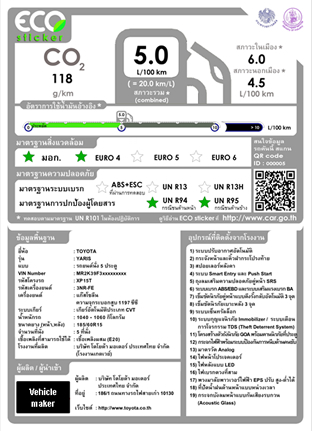
The CO2 ratings of new vehicles will be used as the basis for the new excise tax rates from 1 January 2016. The revised tax scheme is expected to encourage consumers to buy more efficient vehicles.
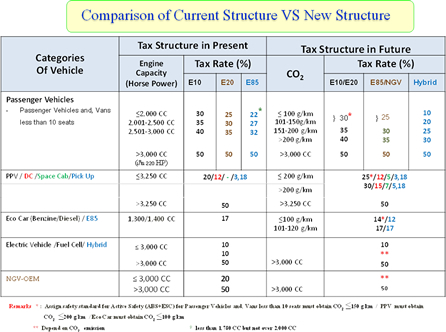
Used Vehicle Fuel Economy Labels:
With proper maintenance and upkeep of a vehicle, the fuel economy should not change too much over time. For this reason the current used vehicle fuel economy labels detail the fuel economy of the vehicle from factory specifications. When a car gets too old however, the fuel economy may change too much to keep consistent with factory specifications, hence why only late model vehicles are labelled.
United Kingdom
The United Kingdom released a used car fuel economy label to dealerships in early August 2009. The used car label is nearly identical to the existing new car label, showing at a glance a car’s carbon dioxide emissions, fuel costs, environmental performance and vehicle tax. The only difference is a new section that explains how the fuel consumption figure is calculated. But, the fuel consumption figure is taken from tests on the vehicle when it was new, so it doesn’t tell you the car’s current fuel consumption. The used car label is so far only a voluntary initiative for dealers, with about 2000 dealers signed-up to participate as of November 2009.
New Zealand
Used vehicles only have the star rating, as opposed to fuel economy information displayed on new vehicles (see above). The label shows a star rating out of 6 – 6 for the most efficient vehicle, half a star for the most inefficient vehicle; the cost of running the vehicle for a year, and finally the cars fuel economy (liters per 100km).
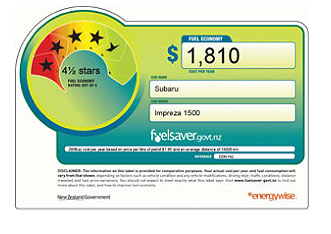
References
- “Background to the Fuel Economy Label.” Low Carbon Vehicle Partnership.
http://www.lowcvp.org.uk/cutting-carbon/fuel-economy-label-background.asp. - Centro Mario Molina Chile, http://www.cmmolina.cl/
- “Chilean Government adopts fuel economy labeling.”http://www.globalfueleconomy.org/updates/2010/Pages/ChileanGovernmentadoptsfueleconomylabeling.aspx
- ‘Improving the Fuel Economy of Road Vehicles: A policy package.’ The International Energy Agency. 2012.
- “Living Green: Sticker Shock.” http://www.thedailygreen.com/living-green/blogs/cars-transportation/5376
- National Association of Automobile Association of South Africa Announces New Vehicles Comparative Fuel Economy Labeling System to Promote Fuel Efficiency Awareness Amongst New Car Buyers.http://www.naamsa.com/papers/20080624/
- New Zealand Transport Agency. http://labeling.fuelsaver.govt.nz/allfaq.html#When did the Energy Efficiency (Vehicle Fuel Economy Labeling) Regulations 2007 come into effect?
- Energy labeling: car manufacturers “prefer” yellow labels
http://english.vietnamnet.vn/fms/environment/120408/energy-labeling--car-manufacturers--prefer--yellow-labels.html
- Presentation of Mr. Le Anh Tu of Vietnam Register at the BAQ/EST Conference in Colombo, Sri Lanka in November 2014
http://baq2014.org/wp-content/uploads/05-VIETNAM.pdf
